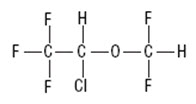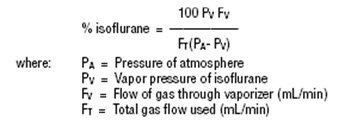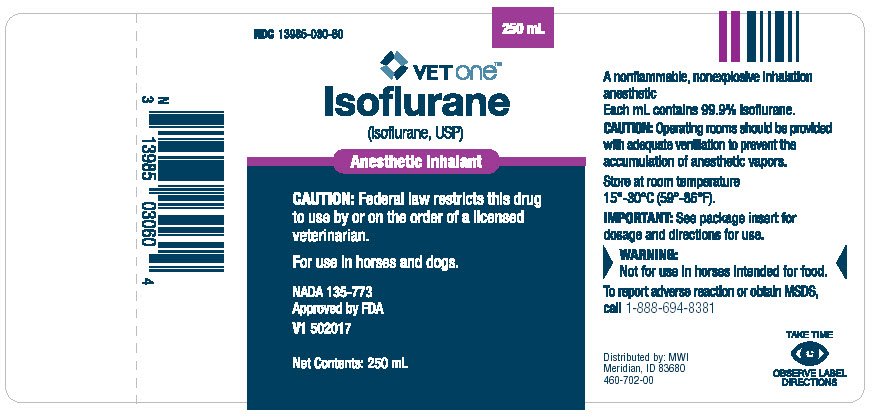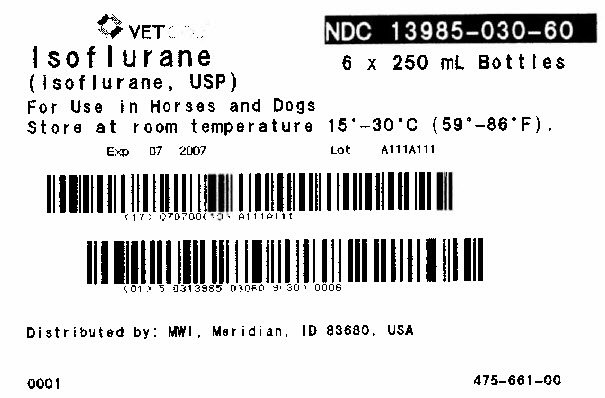Isoflurane Veterinary Prescribing Information
Package insert / product label
Generic name: isoflurane inhalant
Dosage form: FOR ANIMAL USE ONLY
On This Page
WARNING: Not for use in horses intended for food
CAUTION: Federal law restricts this drug to use by or on the order of a licensed veterinarian.
Isoflurane Veterinary Description
Isoflurane (Isoflurane, USP) is a nonflammable, nonexplosive general
inhalation anesthetic agent. Its chemical name is
1-chloro-2,2,2-trifluoroethyl difluoromethyl ether, and its structural
formula is:

Each mL contains 99.9% Isoflurane.
Some physical constants are:
| Molecular weight |
| 184.5 |
| Boiling point at 760 mmHg |
| 48.5°C (uncorr.) |
| Refractive i n d e x n 20/D |
| 1.2990-1.3005 |
| Specific gravity 25°/25°C |
| 1.496 |
| Vapor pressure in mmHg** |
| 20°C 238 |
|
|
| 25°C 295 |
|
|
| 30°C 367 |
|
|
| 35°C 450 |
log10Pvap = A + B/T
where: A = 8.056
B = -1664.58
T = °C + 273.16 (Kelvin)
Partition coefficients at 37°C
| Water/gas | 0.61 |
| Blood/gas | 1.43 |
| Oil/gas | 90.8 |
| Partition coefficients at 25°C - rubber and plastic |
|
| Conductive rubber/gas | 62.0 |
| Butyl rubber/gas | 75.0 |
| Polyvinyl chloride/gas | 110.0 |
| Polyethylene/gas | ~2.0 |
| Polyurethane/gas | ~1.4 |
| Polyolefin/gas | ~1.1 |
| Butyl acetate/gas | ~2.5 |
| Purity by gas chromatography | >99.9% |
| Lower limit of flammability in oxygen or nitrous oxide at 9 joules/sec. and 23°C | None |
| Lower limit of flammability in oxygen or nitrous oxide at 900 joules/sec. and 23°C | Greater than useful concentration in anesthesia. |
MAC (Minimum Alveolar Concentration) is 1.31% in horses1 and 1.28 in dogs6.
Isoflurane
is a clear, colorless, stable liquid containing no additives or
chemical stabilizers. Isoflurane has a mildly pungent, musty, ethereal
odor. Samples stored in indirect sunlight in clear, colorless glass for
five years, as well as samples directly exposed for 30 hours to a 2
amp, 115 volt, 60 cycle long wave U.V. light were unchanged in
composition as determined by gas chromatography. Isoflurane in one
normal sodium methoxide-methanol solution, a strong base, for over six
months consumed essentially no alkali, indicative of strong base
stability. Isoflurane does not decompose in the presence of soda lime
(at normal operating temperatures), and does not attack aluminum, tin,
brass, iron or copper.
Isoflurane Veterinary - Clinical Pharmacology
Isoflurane (Isoflurane, USP) is an inhalation anesthetic. Induction and recovery from anesthesia with Isoflurane are rapid.2,5 The level of anesthesia may be changed rapidly with Isoflurane. Isoflurane is a profound respiratory depressant. RESPIRATION MUST BE MONITORED CLOSELY IN THE HORSE AND DOG AND SUPPORTED WHEN NECESSARY. As anesthetic dose is increased, both tidal volume and respiratory rate decrease.3,6. This depression is partially reversed by surgical stimulation, even at deeper levels of anesthesia.
Blood pressure decreases with induction of anesthesia but returns toward normal with surgical stimulation. Progressive increases in depth of anesthesia produce corresponding decreases in blood pressure; however, heart rhythm is stable and cardiac output is maintained with controlled ventilation and normal PaCO2 despite increasing depth of anesthesia. The hypercapnia which attends spontaneous ventilation during Isoflurane anesthesia increases heart rate and raises cardiac output above levels observed with controlled ventilation.3 Isoflurane does not sensitize the myocardium to exogenously administered epinephrine in the dog.
Muscle relaxation may be adequate for intra-abdominal operations at normal levels of anesthesia. However, if muscle relaxants are used to achieve greater relaxation, it should be noted that: ALL COMMONLY USED MUSCLE RELAXANTS ARE MARKEDLY POTENTIATED WITH ISOFLURANE, THE EFFECT BEING MOST PROFOUND WITH THE NONDEPOLARIZING TYPE. Neostigmine reverses the effect of nondepolarizing muscle relaxants in the presence of Isoflurane but does not reverse the direct neuromuscular depression of Isoflurane.
Indications and Usage for Isoflurane Veterinary
Isoflurane (Isoflurane, USP) is used for induction and maintenance of general anesthesia in horses and dogs.
Contraindications
Isoflurane (Isoflurane, USP) is contraindicated in horses and dogs with known sensitivity to Isoflurane or to other halogenated agents.
Warnings
Increasing depth of anesthesia with Isoflurane (Isoflurane, USP) may increase hypotension and respiratory depression. The electroencephalographic pattern associated with deep anesthesia is characterized by burst suppression, spiking, and isoelectric periods.4
Since levels of anesthesia may be altered easily and rapidly, only vaporizers producing predictable percentage concentrations of Isoflurane should be used (see DOSAGE AND ADMINISTRATION).
The action of nondepolarizing relaxants is augmented by Isoflurane. Less than the usual amounts of these drugs should be used. If the usual amounts of nondepolarizing relaxants are given, the time for recovery from myoneural blockade will be longer in the presence of Isoflurane than in the presence of other commonly used anesthetics.
Not for use in horses intended for food.
Precautions
Isoflurane (Isoflurane, USP), like some other inhalational anesthetics, can react with desiccated carbon dioxide (CO2) absorbents to produce carbon monoxide which may result in elevated carboxyhemoglobin levels in some patients. Case reports suggest that barium hydroxide lime and soda lime become desiccated when fresh gases are passed through the CO2 absorber cannister at high flow rates over many hours or days. When a clinician suspects that CO2 absorbent may be desiccated, it should be replaced before the administration of Isoflurane.
Adverse Reactions/Side Effects
Hypotension, respiratory depression and arrhythmias have been reported.
Overdosage
In the event of overdosage, or what may appear to be overdosage, the following action should be taken: Stop drug administration, establish that the airway is clear and initiate assisted or controlled ventilation with pure oxygen as circumstances dictate.
Isoflurane Veterinary Dosage and Administration
Caution: Operating rooms should be provided with adequate ventilation to prevent the accumulation of anesthetic vapors.
Premedication: A premedication regimen, which may be employed depending upon the patient status, to avert excitement during induction, might include an anticholinergic, a tranquilizer, a muscle relaxant, and a short-acting barbiturate.
Inspired Concentration: The delivered concentration of Isoflurane (Isoflurane, USP) should be known. Isoflurane may be vaporized using a flow-through vaporizer specifically calibrated for Isoflurane. Vaporizers delivering a saturated vapor which then is diluted (e.g., Vernitrol® Vaporizer) also may be used. The delivered concentration from such a vaporizer may be calculated using the formula:

Isoflurane contains no stabilizer. Nothing in the drug product alters calibration or operation of these vaporizers.
Induction:
Horses: Inspired concentrations of 3.0 to 5.0% Isoflurane alone with oxygen following a barbiturate anesthetic induction are usually employed to induce surgical anesthesia
in the horse.
Dogs: Inspired concentrations of 2.0 to 2.5% Isoflurane alone with oxygen following a barbiturate anesthetic induction are usually employed to induce surgical anesthesia in the dog.
These concentrations can be expected to produce surgical anesthesia in 5 to 10 minutes.
Maintenance: The concentration of vapor necessary to maintain anesthesia is much less than that required to induce it.
Horses: Surgical levels of anesthesia in the horse may be sustained with a 1.5 to 1.8% concentration of Isoflurane in oxygen.
Dogs: Surgical levels of anesthesia in the dog may be sustained with a 1.5 to 1.8% concentration of Isoflurane in oxygen.
The level of blood pressure during maintenance is an inverse function of Isoflurane concentration in the absence of other complicating problems. Excessive decreases, unless related to hypovolemia, may be due to depth of anesthesia and in such instances may be corrected by lightening the level of anesthesia. Recovery from Isoflurane anesthesia is typically uneventful.2
How is Isoflurane Veterinary supplied
Isoflurane (Isoflurane, USP) is packaged in 100 mL and 250 mL
amber-colored bottles.
100 mL - NDC 13985-030-40
250 mL - NDC 13985-030-60
References
- Steffey, E.P., Howland, D. Jr., Giri, S. and Eger, E.I.II. Enflurane, Halothane and Isoflurane Potency in Horses. Am. J. Vet. Res. 1977; 38(7):1037-1039.
- Auer, J.A., Garner, H.E., Amend, J.F., Hutcheson, D.P. and Salem, C.A. Recovery from Anesthesia in Ponies: A Comparative Study of the Effects of Isoflurane, Enflurane, Methoxyflurane and Halothane. Equine Vet. J. 1978; 10(1): 18-23.
- Steffey, E.P., and Howland, D. Jr. Comparison of Circulatory and Respiratory Effects of Isoflurane and Halothane Anesthesia in Horses. Am. J. Vet. Res. 1980;41(5): 821-825.
- Auer, J.A., Amend, J.F., Garner, H.E., Hutcheson, D.P. and Salem, C.A. Electroencephalographic Responses During Volatile Anesthesiain Domestic Ponies: A Comparative Study of Isoflurane, Enflurane, Methoxyflurane, and Halothane. Equine Practice 1979; 3: 130-134.
- Klide, A.M. Cardiopulmonary Effects of Enflurane and Isoflurane in the Dog. Am. J. Vet. Res. 1976; Vol 37, No 2: 127-131.
- Steffey, E.P., and Howland, D. Jr. Isoflurane Potency in the Dog and Cat. Am. J. Vet. Res. 1977; Vol 38, No 11: 1833-1836.
[NADA 135-773, Approved by FDA]
Baxter and Isoflurane are trademarks of Baxter International Inc.
VET ONE™
Distributed by: MWI
Meridian, ID 83680
To report adverse reaction or obtain MSDS, call 1-888-694-8381
Revised: February 2007
460-703-00
PACKAGE LABELING - PRINCIPAL DISPLAY PANEL

Container Label
NDC 13985-030-60
250 mL
Logo VET ONETM
Isoflurane
(Isoflurane, USP)
Anesthetic Inhalant
CAUTION: Federal law restricts this drug
to use by or on the order of a licensed
veterinarian.
For use in horses and dogs.
NADA 135-773
Approved by FDA
V1 502017
Net Contents: 250 mL
A nonflammable, nonexplosive inhalation
anesthetic
Each mL contains 99.9% isoflurane.
CAUTION: Operating rooms should be provided
with adequate ventilation to prevent the
accumulation of anesthetic vapors.
Store at room temperature
15°-30°C (59°-86°F).
IMPORTANT: See package insert for
dosage and directions for use.
WARNING:
Not for use in horses intended for food.
To report adverse reaction or obtain JSDS,
call 1-888-694-8381
Distributed by: MWI
Meridian, ID 83680
460-702-00
TAKE TIME
Logo
OBSERVE LABEL
DIRECTIONS
N 3 13985 03060 4

NDC 13985-030-60
6 x 250 mL Bottles
Logo VET ONETM
Isoflurane
(Isoflurane, USP)
For Use in Horses and Dogs
Store at room temperature 15°-30°C (59°-86°F).
Exp 07 2007 Lot A111A111
(17) 070700(10) A111A111
(01) 5 0313985 03060 9(30) 0006
Distributed by: MWI, Meridian, ID 83680, USA
0001
475-661-00
| ISOFLURANE
isoflurane inhalant |
||||||||||||||||||||
|
||||||||||||||||||||
|
||||||||||||||||||||
|
||||||||||||||||||||
|
||||||||||||||||||||
| Labeler - MWI VETERINARY SUPPLY CO (019926120) |
| Registrant - BAXTER HEALTHCARE CORPORATION (005083209) |
| Establishment | |||
| Name | Address | ID/FEI | Business Operations |
|---|---|---|---|
| BAXTER HEALTHCARE SA, dba Baxter Healthcare of Puerto Rico | 154731033 | manufacture | |
